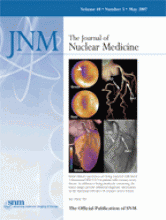Abstract
PET with 18F-FDG has been considered of limited value for detection of bladder cancer because of the urinary excretion of the tracer. The purpose of this study was to investigate the role of PET/CT in the detection and restaging of bladder cancer using furosemide and oral hydration to remove the excreted 18F-FDG from the bladder. Methods: Seventeen patients with bladder cancer (11 without cystectomy, 6 with total cystectomy and urinary diversion) underwent 18F-FDG PET/CT from head to the upper thighs 60 min after the intravenous injection of 370 MBq of 18F-FDG. Additional pelvic images were acquired 1 h after the intravenous injection of furosemide and oral hydration. PET/CT findings were confirmed by MRI, cystoscopy, or biopsy. Results: PET/CT was able to detect bladder lesions in 6 of 11 patients who had not undergone cystectomy. These images changed the PET/CT final reading in 7 patients: Recurrent bladder lesions were detected in 6 patients, pelvic lymph node metastases in 2 patients, and prostate metastasis in 1. This technique overcame the difficulties posed by the urinary excretion of 18F-FDG. Hypermetabolic lesions could be easily detected by PET and precisely localized in the bladder wall, pelvic lymph nodes, or prostate by CT. Seven of 17 patients (41%) were upstaged only after delayed pelvic images. Conclusion: Detection of locally recurrent or residual bladder tumors can be dramatically improved using 18F-FDG PET/CT with delayed images after a diuretic and oral hydration.
Footnotes
-
COPYRIGHT © 2007 by the Society of Nuclear Medicine, Inc.







